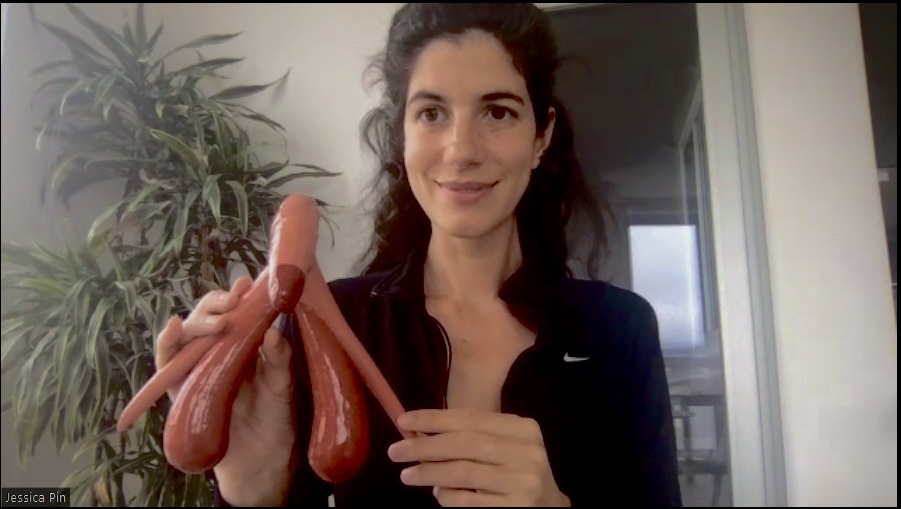Wanita

By Dr. Hannah Nazri
Jessica Pin on clitoral anatomy, labiaplasties, and smart patients

This week, I interviewed Jessica Pin, an activist with the goal of comprehensive and equitable coverage of the clitoral anatomy in Obstetrics & Gynaecology (OB/GYN) textbooks.
Pin, who had labiaplasty when she was 18, believes that the dorsal nerves of her clitoris were unintentionally cut and fears that the rise of labiaplasty means that more women will be harmed by surgeons who are unaware of the superficial nerves and vasculature of the clitoris. Note that in most labiaplasty cases, clitoral hood reduction is done concurrently – even though many women, including Pin did not consent for clitoral hood reduction. Pin had only consented to the “excision of redundant labia” but was aghast when her labial minora was completely amputated and her clitoral hood reduced. This led to the irreversible loss of sensation in the clitoris.
Following this experience, Pin found that the sexual function of labia minora was rarely described in OB/GYN textbooks and literature, and the clitoral anatomy in OB/GYN textbooks was inadequate. Specifically, the distal course of the dorsal nerves was missing. Since then, Pin has participated in cadaveric dissections of the vulva and has co-published a study on clitoral anatomy (Kelling, Erickson, Pin, & Pin, 2020) with Dr. Paul Pin, her father and plastic surgeon at Baylor University Medical Center in Dallas, Texas which was featured in the New Scientist. Pin has also written letters and emailed 20+ residency programmes in the US as well as textbooks authors to include the correct clitoral anatomy with 5 textbooks updated, including Te Linde’s Operative Gynecology and Williams Gynecology, and 15+ more due for updates, including Netter, Moore, and Grant. Her work and experience have been featured in many podcasts and interviews which can be found here. You can follow Jessica Pin on Instagram here.
Dr. Hannah Nazri (HN): I have read and heard horror stories of botched labiaplasties leading to chronic pain and loss of sexual function. We now know these are due to lack of complete female genitalia anatomy knowledge. Would you recommend labiaplasty to women if all doctors are properly versed with clitoral anatomy vasculature and innervation?
Jessica Pin (JP): It must be understood that even the most carefully considered labiaplasty cuts out sexually sensitive tissue. We cannot get rid of labiaplasty as long as there is demand. What we need is standardised procedures which are carefully considered according to patients’ needs and informed consent. However, my personal opinion is that cosmetic labiaplasty or any form of female cosmetic genital surgeries should not be done. To reiterate my point, I would say ‘yes’ to labiaplasty for medical reasons. Definitely ‘no’ to clitoral hood reduction. Clitoral hood reduction without consent should be seen as clitoral surgery without consent, as most of the clitoral hood is shaft skin. Given the dorsal nerves are superficial beneath the skin, there is a very real risk of clitoral denervation, which typically goes unrecognised.
HN: What do you think of outcome studies which suggested improvement in sexual function with labiaplasty?
JP: Many outcome studies have suggested an improvement of sensation – but they do not typically ask the right questions. For example, ‘improved satisfaction’ does not indicate improved sensation. Additionally, reports of improved function can be expected given it is well established that improved body image leads to improved sexual function in women. It has also been shown that women seeking labiaplasty have higher rates of sexual dysfunction, likely due to poor body image. Women seeking surgery have also been reported to be uncomfortable engaging in activities like oral sex. So of course, if surgery helps them finally allow their partners to give them oral sex, their sexual satisfaction will improve.
Because of all these issues, reports of improved sexual function are misleading. And the small percentages of women who experience reduced sensation tend to get dismissed. Surgeons don’t really stop to ask why those women are reporting lost sensation, but those are likely patients for whom a physical loss of sensation has outweighed the benefits of improved body image. It would be interesting to have a study where two groups of women who are deciding to get labiaplasty to be allocated to ‘education’ and ‘surgery’ groups and see which groups will report better outcomes in sexual satisfaction.

The online world is definitely full of horror stories about botched labiaplasties – many women have contacted me regarding total amputation of their labia minora and clitoral hood reduction without consent. But I’m not sure doctors are hearing these stories. I had my fair share of being dismissed by doctors. One doctor told me when I was complaining about sexual dysfunction, that I just needed “to relax.” Another told me I just needed to “fall in love.” Every doctor I saw dismissed my perception that my labiaplasty had caused damage, which I was hoping could be fixed.
Additionally, very few of these cases, if any, have gone to court, as lawyers generally will not take them. Women may blame themselves, not understand what happened until too late, or simply get discouraged after being turned away by law firms. It is, however, nice to see a doctor finally being held accountable for botched labiaplasties in the mainstream media recently in Australia. But this particular case involves a medical student who was harmed at age 13. Her being a medical student helps with her credibility.
It must be understood that even the most carefully considered labiaplasty cuts out sexually sensitive tissue.
Jessica Pin Tweet
HN: So, is labiaplasty a form of female genital mutilation (FGM) type II?
JP: It is not FGM if we properly consent women. However, most patients are not properly consented in my opinion.
HN: But surely, it is difficult to consent women appropriately, if they themselves are swamped with advertisements by clinics online and pornography. I read a paper (Sharp, Tiggemann, & Mattiske, 2014) which suggested that online mainstream media and pornography, coupled with peer influence and negative comments from their partners correlated positively with wanting to have labiaplasty.
JP: Pornography is not the problem. I don’t know where this all came from. When I first watched pornography, I was surprised to see that these women have the same protruding labia minora that I had prior to labiaplasty. I had been thinking, for years, that I’d really needed surgery, that I’d had this awful, embarrassing problem. And when I first watched porn, I realised that was all a lie. And I also realised that what I’d been getting told, that I “looked normal” after my surgery, was a lie too.
Pornography does show genital diversity. In fact, Nina Hartley, a porn star, tweeted that the idea that many porn stars have had labiaplasties is “garbage.” Porn star Stoya has pointed out that hard-core porn is actually “a rare place where vulvas with all kinds of labia are shown and presented as desirable, are flood-lighted and zoomed into rather than hidden.”
What doesn’t show genital diversity is medical literature. When was the last time you saw an “outtie” (protruding labia minora) in a medical textbook?
HN: Perhaps early pornography was less female genitalia diverse?
JP: Well, Nina Hartley has been in the pornography industry since 1984.
But perhaps, there are women who watch pornography and see all these large labia minora and think that it’s due to having more sex. After all, the myth that sexual activity leads to larger labia minora is so pervasive it even gets published in major medical textbooks and peer-reviewed medical journals. There is no evidence supporting this of course.
The way I ended up wanting a labiaplasty had nothing to do with porn. What happened was, at 17, I had no insecurities about my labia minora, but I didn’t know what a clitoris was. So I Googled to find out. And that was the first time I even learned the terms ‘vulva’ and ‘labia minora’. When I saw the vulva on the Wikipedia page didn’t look like mine, I Googled those terms as well to see if I was normal. When I did an image search for ‘labia minora’ I got before and after photos for labiaplasty. And I ended up on medical websites getting bombarded with stigmatising misinformation. That’s how I became insecure.
The problem is doctors will repeat false information found in peer-reviewed journals and textbooks without fact-checking. So at 17, I read doctors saying excess androgens, aging, and masturbation cause for labia minora hypertrophy on medical websites and in medical journals. These claims are unsupported. Even the word ‘hypertrophy’ is problematic – at least to a non-medical audience, because this terminology pathologises normal labia minora. In medical literature, ‘hypertrophy’ has been defined to include all women who have protruding labia minora, which has generally been found to be about half the female population.
I think a lot of girls also become insecure about their labia minora because they are taught to conceptualise their genitals as internal. We teach the word ‘vagina’. We don’t teach ‘vulva’. And when you’re little, everything is typically hidden. But when girls go through puberty, the labia minora often gets much bigger. But no one talks about this, and no one is expecting it. So many girls are left wondering if there is something wrong. And surgeons are all too willing to exploit that for profit. It’s not ethical.
HN: What would you say to medical students and doctors?

JP: I think it’s important to recognise that doctors are considered the authority on medical information. And they need to be trusted as such for the healthcare system to work. Patient autonomy and informed consent depend on doctors’ providing accurate information. And patient compliance depends on patients’ trusting doctors. So when doctors share false or unsupported claims, this precludes informed consent and eventually erodes patient trust in all doctors as credible sources of information.
It’s important to recognise that medical misinformation is a public health problem. And if you see a colleague misinforming patients, understand that isn’t just going to impact their patients. In the long run, it’s going to impact you as well. The trust your patients give you is based on a reputation. And that reputation must be upheld. So doctors must hold themselves and their colleagues accountable for providing accurate information.
It is important doctors be more questioning of the claims they read. Are they backed by evidence? Look for primary sources to ensure they are. It is important to be less certain and more inquiring when evaluating new information and deciding what information to share. Before sharing any information on social media, on websites, in medical journals, or in medical textbooks, first ask yourselves, “Would I share this if I had to bet $10,000 it is accurate?”
And if you see colleagues sharing information that is either false or backed by no evidence, understand this has potentially widespread implications for trust in medicine in the long term – it has implications for how much future patients will trust you. And so it is important to speak up, to ensure accuracy and integrity. This applies to information online as well as in medical journals and textbooks.
Too often, there is an eminence-based standard for what is considered true rather than an evidence-based standard. In this system, false information is believed without evidence if it comes from a source seen as an authority and if it fits a convenient narrative. But if it’s communicated by a layperson, even if backed by evidence, it falls on deaf ears. So I think it’s really important to take a step back, examine biases, and evaluate what evidence there is for the information being presented, regardless of who it’s coming from and whether you want to believe it.
It is also important to recognise that knowing what you don’t know is the most important thing, especially given how accessible medical information is. Making informed medical decisions for your patients depends more on your ability to recognise and access the relevant information as needed than to have memorised it all. We need a medical culture where it’s okay to not know things and it’s okay to be wrong. What patients need from doctors is a growth mindset – openness to feedback and a willingness to learn and to improve.
Also, many doctors are now on social media, and most just use it to keep up with their friends or for self-promotion. And there is nothing wrong with that. But it’s important to realise social media can be a powerful tool for activism, for disseminating information, and for ultimately changing medicine. While it takes an average of 17 years for new medical information to get disseminated and applied in clinical practice (according to Eric Topol), information can go viral on social media overnight. New ideas about how to practice medicine can go viral overnight. So there is all this potential for social media as a means for changing medicine that is underutilised.
Notably, a #MedBikini protest went viral on Twitter and Instagram leading a study (Hardouin et al., 2020) on professionalism of female doctors online to be retracted. So, I am wondering how this same enthusiasm could be applied to activism that can help patients.
But there are some doctors out there who utilise social media in really amazing ways, helping to advocate for changes in medicine as well as educating laypeople. Some of my favourites are Dr. Jill Krapf, Dr. Rachel Rubin, Dr. Teresa Irwin, Dr. Sasha Davenport, Dr. Amy Lasky, and Dr. Jocelyn Fitzgerald. One thing amazing was how urogynecologist, Dr. May Sanaee, reached out on Twitter and had me help lecture her OB/GYN residents. I’ve also been invited to Dr. Kelly Casperson and Dr. Delvena Thomas’ podcasts after connecting on Instagram. I think that really speaks to the power of social media.
It is really important to recognise that doctors and patients have a shared goal: to improve medicine.
Jessica Pin Tweet
HN: So, what would be the best way for doctors to communicate and interact with patients online?

JP: I think it is really important to recognise that doctors and patients have a shared goal: to improve medicine. Often, what you see is doctors feeling attacked or threatened by patient activists, and this can lead to publicly bullying those activists, which is really damaging.
For example, I had a Harvard ER doctor make multiple comments to me on Instagram, saying he would have preferred “someone knowledgeable on the subject” publish my study on clitoral anatomy, rather than “someone who suffered emotional trauma at the hands of her father, who is a plastic surgeon.” This was an incredibly twisted interpretation of what happened to me: my father trusted a reputable OB/GYN to perform a labiaplasty. He told me I did not write my paper, though I did. I was not listed as first or last because we needed to make sure we got funded and published, as I am not an MD. “Without an MD, you embarrass yourself,” he said. “The outlandish claim is: you claim to be an anatomy expert without an MD or PhD on anatomy.” But I am an expert.
It’s important to recognise that while doctors used to have a monopoly on medical information, they don’t anymore. Medical journals and textbooks are pretty readily available. And there are a lot of smart people who are not doctors, and a lot of those smart people may have health problems they’ve been really incentivised to learn about. So what you’re going to see is smart people who have educated themselves. While medical education provides broad training, patients have more incentive to become specialists on information relevant to their particular condition, so it’s important to consider they may have information you don’t. And while formal credentials are an important means of ensuring someone has a certain basis of knowledge and training, it’s important to not automatically dismiss someone based on a lack of medical credentials.
In other fields like engineering, it is now accepted that people can be self-taught experts. On one podcast I listened to, tech entrepreneur Jason Calacanis opined that major tech companies will actually value you more if they see that you have acquired skills and knowledge on your own rather than paying for formal credentials. So outside of medicine, there’s this accepted idea that you can gain knowledge without being formally taught. But many doctors hold fast to an idea that this isn’t possible, and it’s ego-driven behaviour that, again, has the potential to make everyone look bad.
So I think there is a need for doctors to listen to patients online and to engage respectfully with us. One OB/GYN told me that no one would listen to my message that clitoral anatomy shouldn’t be taught. She told me that I would need to find an OB/GYN (but not her!) to champion my cause or no one would listen. Early on, I thought this too, which was why I sent hundreds of emails out in 2018 telling female OB/GYNs there was an opportunity to become famous by taking my message to the media basically. It didn’t work. But fundamentally movements should be supported based on merit, not who is leading them. I’m motivated because I need to stop what happened to me from happening to others as an affirmation of my dignity. I think it’s really important to allow patients dignity.
It is again also extremely important to share accurate information and to maintain ethical behaviour. Right now, there are doctors on TikTok, a platform for teens, telling them large labia minora are considered unattractive and are caused by aging. This is not true. There are other doctors running ads on Facebook saying labiaplasty is “like a haircut for your genitals.” In one case, a plastic surgeon used an artist’s vulva diversity art, without her permission and against her wishes, to promote her plastic surgery practice on Instagram and TikTok. When I called her out, she threatened to sue me.
People have criticised my tactics. I’ve been perhaps too critical of doctors at times, too blunt, too aggressive. But it is super hard when you have suffered harm and to see others continue to be harmed for the same reasons when there is an easy solution, but no one will listen. One OB/GYN said, “The message is just as important as the messaging,” as the reason she could not support my message. But it shouldn’t work like this. It really is the message that matters, especially when it affects lots of people, and if someone is hurt, their messaging isn’t going to be perfect.
So I’d say the most important thing is to listen to patients. They might have insight or knowledge you don’t. They might see problems and solutions you don’t, as they don’t have the same biases. In this interview of journalist Morgan Housel, he said, “It’s impossible to be objective about a field you get your paycheck from.” There’s a reason most whistle-blowers are outsiders.
HN: Recommended textbooks or books?
JP: I would recommend ‘The Patient Will See You Now: The Future of Medicine is in Your Hands’ by Dr. Eric Topol, a cardiologist and editor and chief of Medscape. His book details the history of paternalistic medicine and how medicine can progress by listening to ‘smart patients’. In explaining how medicine will change with technology, he also talks about the need for transparency, acknowledging and learning from harm, and why medicine is so resistant to change.
There’s also ‘Mindset: How You Can Fulfil Your Potential’ by Carol Dweck. I think too often, medical training encourages a fixed mindset rather than a growth mindset. So often, doctors have taken me telling them they don’t know something as a personal attack. But it isn’t. It’s important to focus on growth and learning when confronted with errors, not just in medicine, but in all facets of life.
Recently, I’ve been reading ‘Willful Blindness‘ by Margaret Heffernan. It’s about “why we ignore the obvious at our peril.” In one example, she talks about how doctors carried on X-rays for 25 years after it was shown that a fetus exposed to an X-ray was twice as likely to develop cancer within the next 10 years. Study after study confirmed the finding, but no one likes to be told they’ve been doing something wrong. And when a finding contradicts an identity, such as that doctors are authoritative, smart, good people, that’s very threatening. And these sorts of psychological threats keep people from seeing clearly.
As for textbooks, I recommend the ‘Anatomic Study of the Clitoris and the Bulbo-Clitoral Organ’ by Vincent Di Marino and Hubert Lepidi. Two caveats: there are some terminological issues with how the clitoral hood and prepuce are defined as two different parts of the clitoral hood, and they claim the clitoris has 8,000 nerve endings, for which there is no evidence. Otherwise, this is the most comprehensive source on the clitoris.
HN: Thank you Jessica for spending time with me today. I learnt a lot from you!
JS: You’re welcome.
Like what you read?
More from Dr. Hannah Nazri here.
References
Hardouin, S., Cheng, T. W., Mitchell, E. L., Raulli, S. J., Jones, D. W., Siracuse, J. J., & Farber, A. (2020). RETRACTED: Prevalence of unprofessional social media content among young vascular surgeons. Journal of Vascular Surgery, 72(2), 667–671. https://doi.org/https://doi.org/10.1016/j.jvs.2019.10.069
Kelling, J. A., Erickson, C. R., Pin, J., & Pin, P. G. (2020). Anatomical Dissection of the Dorsal Nerve of the Clitoris. Aesthetic Surgery Journal, 40(5), 541–547. https://doi.org/10.1093/asj/sjz330
Sharp, G., Tiggemann, M., & Mattiske, J. (2014). Predictors of Consideration of Labiaplasty: An Extension of the Tripartite Influence Model of Beauty Ideals. Psychology of Women Quarterly, 39(2), 182–193. https://doi.org/10.1177/0361684314549949

